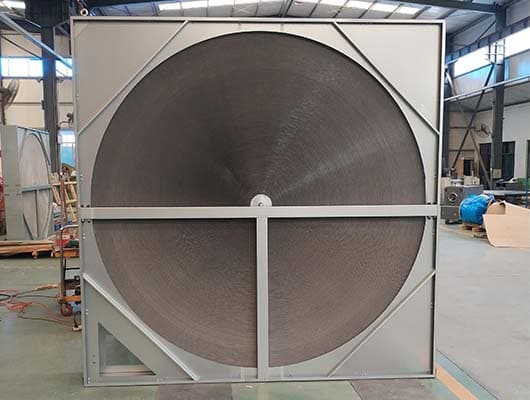Rotary heat exchangers, also known as rotary wheel heat exchangers or thermal wheels, are widely used in HVAC systems, industrial applications, and energy recovery processes. They operate by rotating a wheel embedded with a heat-absorbing material that transfers heat or moisture between incoming and outgoing air streams. Here’s a breakdown of their advantages and disadvantages:
Pros of Rotary Heat Exchangers
- High Efficiency
- Rotary heat exchangers can achieve efficiency levels of 70–90% in energy recovery, significantly reducing energy costs in ventilation and HVAC systems.
- Compact Design
- They require less space compared to some other heat recovery systems, making them ideal for installations where space is limited.
- Energy Savings
- By recovering heat or cooling from exhaust air, they reduce the load on heating and cooling systems, leading to lower energy consumption and operational costs.
- Moisture Transfer
- Hygroscopic coatings or desiccant materials allow rotary heat exchangers to transfer moisture in addition to heat, helping maintain indoor humidity levels without extra equipment.
- Versatility
- Suitable for various applications, including residential, commercial, and industrial setups, they handle large airflow volumes efficiently.
- Reduced Carbon Footprint
- Energy recovery minimizes waste, contributing to sustainability and reduced greenhouse gas emissions.
- Durability
- With proper maintenance, rotary heat exchangers are durable and can have a long operational lifespan.
Cons of Rotary Heat Exchangers
- Cross-Contamination Risk
- There is a slight risk of mixing exhaust and supply air because the rotary wheel physically moves between the two streams. This could be problematic in environments where air purity is critical.
- Regular Maintenance Required
- The rotating wheel and its components require regular cleaning and maintenance to prevent dust buildup and maintain efficiency.
- Initial Cost
- While they offer long-term savings, the initial installation costs can be higher compared to simpler heat recovery systems.
- Limited Temperature Range
- Rotary heat exchangers might not perform well in extremely high or low temperatures, requiring additional equipment in such conditions.
- Noise and Vibration
- The rotating mechanism can produce noise and vibrations, which might necessitate soundproofing or vibration isolation in sensitive environments.
- Potential for Wear and Tear
- The moving parts in rotary heat exchangers are subject to mechanical wear, which could lead to operational inefficiencies or failures if not properly maintained.
- Not Suitable for Some Applications
- Due to the risk of air contamination, they are less suitable for hospitals, laboratories, or other places with strict air quality requirements.
Conclusion
Rotary heat exchangers are a highly efficient and versatile choice for heat and moisture recovery, especially in energy-conscious applications. However, their suitability depends on the specific operational and environmental requirements, as well as considerations for maintenance and air quality.


